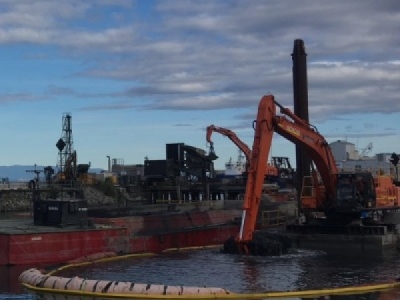
Posted on May 1, 2018
By Iain MacIntyre, Port Strategy
Mounting appreciation of the benefits of using polymers in the treatment of sediments in dredging projects could potentially see the process gain a greater foothold in dewatering-intensive port development works around the world.
In an article recently published in Terra et Aqua, authors Alexis Boisson and Francois Couturier of France-based polyacrylamide manufacturer SNF highlighted successful recent dredging applications in Port-La-Forêt harbour and Israel’s Kishon River.
“For the harbour’s cleaning, 40,000 cubic metres of polluted sediment needed to be flocculated and pumped into geotextile tubes on a dewatering site located four kilometres away,” stated the article.
“The turbidity of the water released has been constantly monitored and kept below the authorised level throughout the project. The benefits of polymer use in conjunction with dewatering tubes are a shorter drying time and higher quality of released water.”
In the river project, over a period of 20 months, some 400,000 cubic metres of material were expected to be removed from the river bottom and treated.
The article explains that the polymers used in the water treatment process are known as “coagulants” (inorganic or organic) and “flocculants” (organic only), with most treatments including one step with each. Their main property is to create small aggregates (“flocs”) with the insoluble colloidal particles contained in the water to be treated. Flocs settle down fine particulates, thus leaving clear water.
Best option
Speaking to Port Strategy, Mr Boisson says that for over a decade his firm has campaigned to explain and promote the concept, pointing out that the municipal water treatment industry has used polymers for over 40 years.
“When fast dewatering is required, using polymers is the best option and there is no alternative,” he tells PS.
He is aware of about 50 polymer dredging projects taking place this calendar year, which are evenly split between port, river and lake sites.
DEME Environmental Contractors research and development manager Stany Pensaert confirms his Belgium-based environmental contracting firm is using polymers in certain applications, including “dewatering of fine sediments or sludges by means of mechanical dewatering (belt presses, centrifuges) or by geotubes”.
“Without polymers (or flocculants) the particles are so fine that they would go through the filter cloth (in case of presses or geotubes) or would hardly separate from the water (centrifuges). So you just need them in case of any type of mechanical dewatering.
“As far as I can see, alternatives do not exist. If you don’t want to use polymers, the dewatering techniques described are just not applicable.”
“Still emerging”
Boskalis Environmental project engineer/process manager Ron Dielhof and process engineer Mark Lugthart say their Netherlands-based firm also uses polymers prior to the mechanical dewatering of both contaminated soils and contaminated sediments. They note the benefits as including an increased settling speed and a typically smaller footprint for project operations.
“We have close contact with the manufacturers; for our operations in the Netherlands a multipurpose product has been created together with the manufacturer,” say the pair.
Although acknowledging polymers are “still emerging” in the port sector, the pair note they have been successfully used in major sediment remediation projects at Fox River, Hudson River and Lake Onondaga.
“If a port is subjected to maintenance dredging the sediments are often suitable for disposal at sea or sometimes in confined disposal facilities,” they say. “In the event of contaminated sediments, polymers are often used to speed up the settling rates and separate out a large volume of water. The settled sludge is then often dewatered which reduces transportation and disposal costs.”
With regards to potential limitations, Mr Pensaert notes the use of polymers is most suitable for dewatering projects for environmental dredging works “where the sediments are really fine and where you want to concentrate these contaminated sediments in a disposable filter cake”.
“In normal dredging projects, which are actually construction material supply works, the dredged material is sandy, with only some fines. The dredged material is then pumped into large reclamation areas where it has sufficient time to settle in order to clear the transport water.”
He believes that most sizeable projects have reclamation areas that are large enough to avoid the use of polymers. Cost can also be an issue as polymer use can add about €1 per cubic metre of dredged material.
Environmental concerns
Mr Dielhof and Mr Lugthart also point out that although polymers are biodegradable there are some concerns that polymers can be environmentally harmful when discharged into receiving waters. However, usually they are used in concentrations that are so low that the impacts are minimal or non-existent.
They note that project size is of lesser importance than capacity in the decision to use polymers: “Dry powder polymers need preparation time before use – there are emulsions available but those are in most cases not economically interesting for large projects.”
Project location also drives the choice of whether to use polymers or not, as is the ultimate final destination of the sediments.
“It depends on what the project requirements are,” they say. “Some projects have the availability of large drying fields or ponds where they can transfer the sediments into. Other projects don’t have that luxury and need alternative methods for storing the sediments – polymers are then a great solution.”
In conclusion, SNF’s Mr Boisson predicts increasing use of polymers in dredging applications where sediment has been polluted. Some big ports could even create a fixed treatment plant to treat sediment.
Source: Port Strategy





